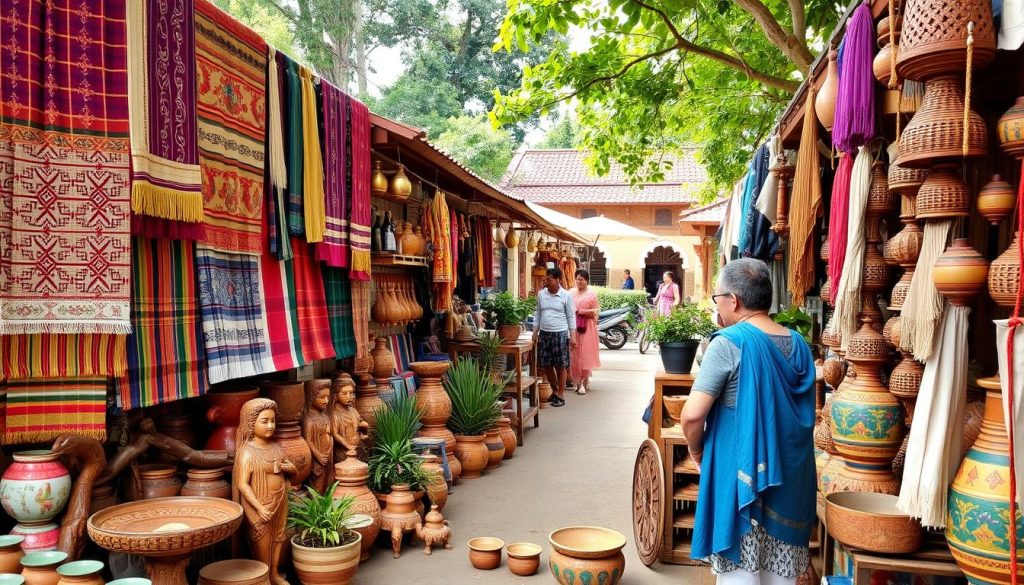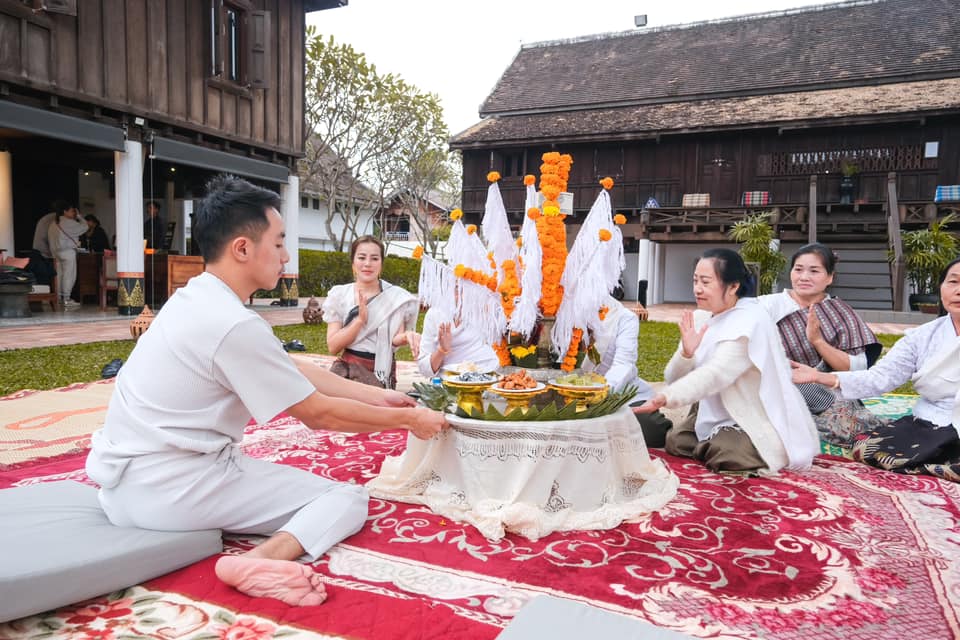1. Overview
Lao handicraft shops in Vientiane offer a rich selection of traditional, handmade items that showcase the country’s cultural heritage. These shops provide a variety of crafts, from textiles and silk to woodwork and ceramics, created by skilled artisans. They offer a chance to experience and take home authentic pieces of Lao craftsmanship.
- Name: Lao Handicraft Shops
- Location: Vientiane, Laos
- Coordinates: Typically in central Vientiane (17.9750° N, 102.6340° E)
- Best visited: As part of a cultural exploration of Lao art and traditions
2. History of the Place
Lao handicrafts are a reflection of the country’s long-standing cultural traditions. Many of the techniques have been passed down through generations, with an emphasis on sustainability and craftsmanship. These items are often made by local artisans in rural villages, with a focus on using natural, locally-sourced materials.
- Tradition: Handicrafts in Laos have been practiced for centuries
- Materials: Common materials include silk, cotton, bamboo, wood, and ceramic
- Artisans: Many artisans work in rural villages, preserving traditional techniques
- Textiles: Lao silk weaving is highly regarded and known for its intricate designs
- Woodwork: Skilled craftsmen create sculptures, furniture, and decorative items
- Ceramics: Traditional ceramics include bowls, pots, and decorative pieces
- Baskets: Handwoven bamboo baskets are a staple of Lao craftsmanship
- Craftsmanship: Many shops focus on fair trade practices and support local artisans
- Cultural Heritage: Items often reflect Buddhist symbols and themes of Lao life
3. Location
4. What Makes “Lao Handicraft Shops” Popular? + Recommended YouTube Video
Lao handicraft shops are popular for their authentic, high-quality products that reflect the rich cultural and artistic traditions of Laos. Visitors are drawn to the beauty and craftsmanship of the items, as well as the opportunity to support local artisans. These shops offer unique souvenirs that are meaningful and one-of-a-kind.
- Authentic Craftsmanship: Traditional items made by skilled local artisans
- Cultural Value: Each piece tells a story of Lao traditions and beliefs
- Unique Souvenirs: Ideal for bringing home a piece of Lao heritage
- Fair Trade: Many shops focus on supporting rural communities and artisans
5. Overall Ratings (1 to 5 Stars)
Lao handicraft shops are highly rated for their quality, authenticity, and cultural significance. They are an excellent place to purchase unique and meaningful items. Many visitors enjoy not only shopping but also learning about the traditional techniques behind the products.
- Overall Rating: ⭐⭐⭐⭐⭐ (5/5)
- Cultural Significance: ⭐⭐⭐⭐⭐ (5/5)
- Authenticity: ⭐⭐⭐⭐⭐ (5/5)
- Product Quality: ⭐⭐⭐⭐⭐ (5/5)
- Atmosphere & Environment: ⭐⭐⭐⭐☆ (4/5)
- Tourist Friendliness: ⭐⭐⭐⭐☆ (4/5)
6. Weather
Vientiane experiences a tropical climate, with hot temperatures year-round and a distinct wet season from May to October. The best time to visit the handicraft shops is during the dry season (November to February), when the weather is cooler and more pleasant for walking around the city and shopping.
- Best Time to Visit: November to February (dry season)
- Temperature Range: 25–30°C (77–86°F)
- Wet Season: May to October (frequent rainfall)
- Dry Season: Ideal for outdoor activities and shopping
7. Nearest Five Hotels
Here are five nearby hotels for visitors exploring the handicraft shops in Vientiane. These hotels offer convenient access to the city’s cultural attractions, including its vibrant handicraft scene.
- Sabaidee@Lao Hotel: Comfortable, modern amenities in central Vientiane
- City Inn Vientiane: Budget-friendly with a central location
- Lao Plaza Hotel: Luxury accommodations with excellent facilities
- Vientiane Garden Hotel: Quiet, scenic hotel near the city center
- Ibis Vientiane Nam Phu: Affordable and conveniently located hotel
8. Timings
Lao handicraft shops in Vientiane typically operate from 9:00 AM to 6:00 PM. However, it is advisable to check the specific timings of individual shops, especially during festivals or public holidays, when some places may close earlier or remain closed for the day.
- Opening Hours: 9:00 AM – 6:00 PM daily
- Best Time to Visit: Early morning or late afternoon to avoid crowds
- Closed Days: Some shops may close during national holidays
9. Time Required to Visit
A visit to a handicraft shop typically lasts between 30 minutes to 1 hour, depending on how much time you wish to spend browsing. If you’re visiting several shops or exploring an artisan village, you might want to allocate a few hours to see a variety of products.
- Visit Duration: 30 minutes – 1 hour per shop
- Extended Visit: 2–3 hours if visiting multiple shops
- Ideal for browsing: Spend time learning about the techniques behind each product
10. Entry Fees & Ticket Booking Details
Most handicraft shops in Vientiane are free to enter. Some specialized exhibitions or artisan workshops may charge an entry fee for guided tours or demonstrations. It is also common to buy directly from the shops, and prices vary depending on the item.
- Entry Fee: Free (unless participating in a workshop or exhibition)
- Booking: Not required for visiting shops; some workshops may require reservations
- Payment: Cash (Kip) or credit cards are often accepted
11. Things to See & Do
During your visit to Lao handicraft shops, you can explore a wide variety of products, including silk scarves, woven baskets, wooden carvings, and pottery. Some shops also offer workshops where you can learn traditional techniques from local artisans.
- Admire the intricate weaving of silk and cotton textiles
- Purchase unique, handmade goods like pottery, baskets, and jewelry
- Learn about the traditional techniques used by local artisans
- Take part in craft-making workshops if available
- Support local artisans by purchasing fair trade products
12. Best Time to Visit
The best time to visit Lao handicraft shops is during the dry season when the weather is cooler, making it easier to explore the city. The shops can get busy during major festivals like the Lao New Year, so visiting earlier in the day can ensure a more relaxed experience.
- Best Season: November to February (dry season)
- Best Time of Day: Early morning or late afternoon
- Avoid: Midday during peak tourist seasons or festivals
13. Nearest Parking Spots
Parking is available at or near most handicraft shops in Vientiane. However, in busy areas, street parking may be limited. Consider using tuk-tuks or taxis for a more convenient way to visit multiple shops in one day.
- Street Parking: Available near most shopping areas
- Public Parking: Located near larger venues like malls and markets
- Tuk-Tuks: Ideal for exploring multiple shops without parking concerns
14. Tips for Visitors
When visiting Lao handicraft shops, it’s important to dress comfortably and be respectful of local customs. Many shops sell items that make excellent souvenirs, and it’s a good practice to ask about the history behind each item. Don’t hesitate to bargain, but always do so respectfully.
- Dress Comfortably: Be prepared to walk and explore
- Respect Local Customs: Ask for permission before taking photos
- Support Local Artisans: Purchase directly from artisans to help support their craft
- Bargaining: Common in markets, but always be respectful
15. How to Reach the Place
Lao handicraft shops are typically located in central Vientiane. The most common way to explore these shops is by foot, tuk-tuk, or bicycle, especially if you are exploring multiple shops in one area.
- By Foot: Many shops are within walking distance in the city center
- By Tuk-Tuk: Convenient and affordable transport for short trips
- By Bicycle: A popular option for local exploration
- By Taxi: Ideal for reaching more distant shops or markets
16. Nearby Attractions to Combine for the Visit
While visiting Lao handicraft shops, you can also explore other cultural landmarks in Vientiane. Many of these attractions are nearby and provide a great way to learn more about the country’s history, culture, and traditions.
- Patuxai: Victory monument offering panoramic views
- Wat Si Saket: The oldest surviving temple in Vientiane
- That Luang Stupa: Laos’ most iconic landmark
- COPE Visitor Centre: A museum showcasing Laos’ UXO history
- Mekong Riverfront: Scenic views, local food, and shopping opportunities


